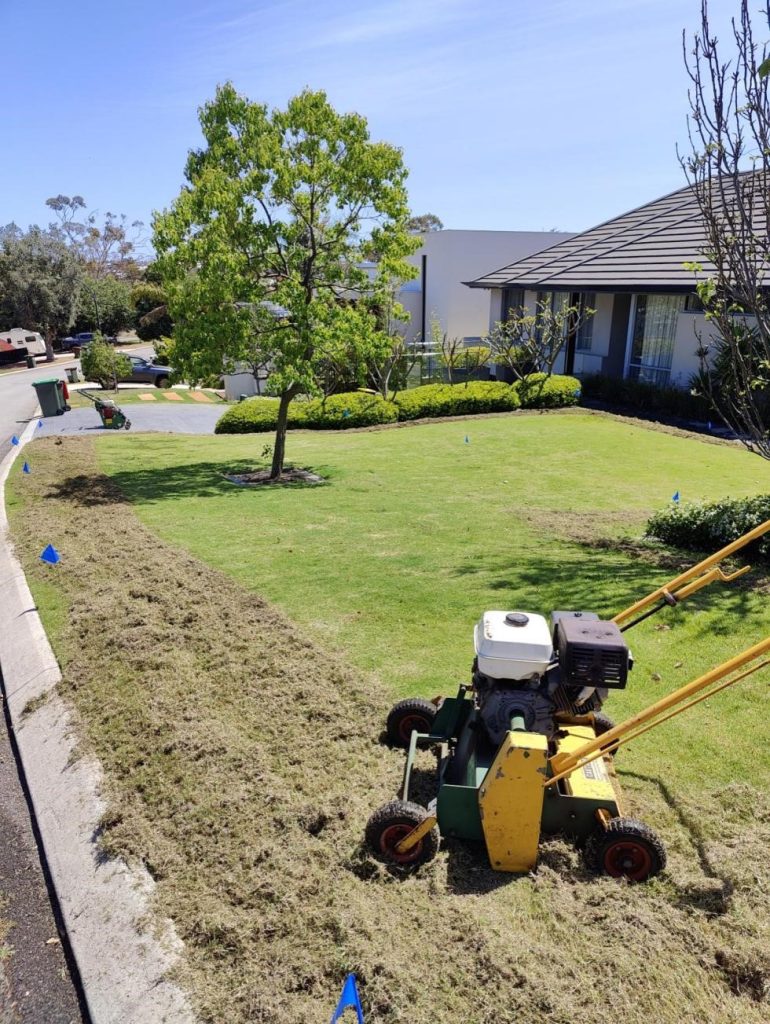Buffalo lawns are one of the most popular turf choices in Australia thanks to their durability, soft texture, and ability to handle our climate. However, even this hardy grass type needs regular care to maintain its lush green appearance. One of the most important maintenance steps is dethatching—and knowing when to do it can make all the difference.
At Premier Lawns, the team specialises in Dethatching Buffalo Lawn services across Perth. They know exactly how to identify when your lawn needs help and how to restore it to full health using a professional Lawn Dethatching Service. If you’re unsure whether your buffalo lawn is due for dethatching, this guide will help you spot the signs.
What is Thatch and Why is it a Problem?
Thatch is a layer of dead grass, roots, and organic matter that builds up between the green blades and the soil surface. A small amount of thatch—less than 1cm—is normal and even beneficial, as it can help retain moisture and protect the roots.
The problem starts when the thatch layer becomes too thick. This prevents water, air, and nutrients from reaching the soil and the grass roots, causing the lawn to weaken. Buffalo grass, with its dense growth habit, tends to build up thatch faster than other varieties, so regular monitoring is important.
Signs Your Buffalo Lawn Needs Dethatching
1. The Lawn Feels Spongy Underfoot
One of the easiest ways to detect excessive thatch is to simply walk across your lawn. If it feels soft and spongy instead of firm, the thatch layer may be too thick. This is a common early warning sign for buffalo turf.
2. Water is Running Off Instead of Soaking In
If you water your lawn and see puddles forming or water running off quickly, the thatch could be blocking moisture from reaching the soil. This forces the roots to grow within the thatch layer instead of deeper into the ground, making your lawn more drought-prone.
3. Grass Appears Thin or Patchy
When nutrients can’t penetrate the soil, your buffalo lawn may start to thin out, leaving bare or uneven patches. If you notice your grass isn’t responding well to fertilising or watering, thick thatch could be the reason.
4. Roots are Growing in the Thatch Layer
You can test this by using a small spade to remove a section of turf. If the majority of the roots are tangled within the thatch rather than growing into the soil, it’s time to consider a Lawn Dethatching Service.
5. Increased Pests and Diseases
A thick thatch layer creates a warm, damp environment that can attract insects and fungal growth. If you notice signs of lawn pests or recurring lawn diseases, dethatching may be necessary to reduce these issues.
The Risks of Ignoring Excessive Thatch
Delaying dethatching can cause serious long-term problems for your buffalo lawn, including:
- Reduced drought resistance
- Stunted growth and poor colour
- Greater risk of lawn pests and fungal diseases
- Increased water runoff and waste
- Higher maintenance costs in the long run
By scheduling regular Dethatching Buffalo Lawn maintenance, you protect your investment and keep your lawn looking its best.
How Often Should You Dethatch a Buffalo Lawn?
In Perth’s climate, most buffalo lawns need dethatching every 2–3 years, but the exact timing depends on how quickly thatch builds up. Lawns in high-traffic areas or those that receive frequent fertilising and watering often develop thatch faster.
The ideal time to dethatch is during the warm growing season—late spring to early summer—when buffalo grass is actively growing and can recover quickly.
What Happens During a Professional Lawn Dethatching Service?
When you book a Lawn Dethatching Service with Premier Lawns, the process is tailored to your lawn’s specific needs.
- Inspection – They measure the thatch depth and assess the lawn’s overall condition.
- Preparation – The grass is mowed short to make dethatching more effective.
- Dethatching – Specialised machines slice through and lift the thatch layer without damaging healthy roots.
- Cleanup – All debris is removed, leaving the lawn ready for new growth.
- Aftercare – Often paired with aeration, fertilising, or overseeding for a full lawn rejuvenation.
Benefits of Dethatching Your Buffalo Lawn
- Better Water Absorption – Water reaches the roots instead of running off.
- Improved Nutrient Uptake – Fertiliser can penetrate the soil more effectively.
- Stronger Root Growth – Roots grow deeper, improving drought resistance.
- Thicker, Healthier Grass – Space for new shoots to grow without competition from dead matter.
- Reduced Pest and Disease Risk – Less shelter for insects and fungal spores.
Why Choose Premier Lawns for Dethatching Buffalo Lawn Services?
Premier Lawns combines years of experience with professional-grade equipment to deliver precise dethatching without damaging your turf. Their team understands the unique growth habits of buffalo grass and knows how to time the process for the best results.
They don’t just remove the thatch—they also provide aftercare advice and, if needed, pair dethatching with aeration and fertilising to give your lawn a complete health boost.
Aftercare Tips for a Dethatched Buffalo Lawn
Once your lawn has been dethatched, a little extra care will help it recover quickly:
- Water Well – Keep the soil consistently moist to encourage new growth.
- Fertilise – Apply a balanced fertiliser to feed the recovering grass.
- Avoid Heavy Traffic – Give the lawn time to strengthen before walking or placing heavy objects on it.
- Mow Carefully – Wait until the grass has grown back before resuming regular mowing.
Final Thoughts
Knowing when to dethatch your buffalo lawn is key to maintaining its health, colour, and density. If your lawn feels spongy, struggles to absorb water, or has visible signs of thinning, it may be time to book a Lawn Dethatching Service.
With Premier Lawns, you can be confident your Dethatching Buffalo Lawn service will be done at the right time, in the right way, for long-lasting results. Don’t wait until the thatch causes permanent damage—give your buffalo lawn the fresh start it needs today.







